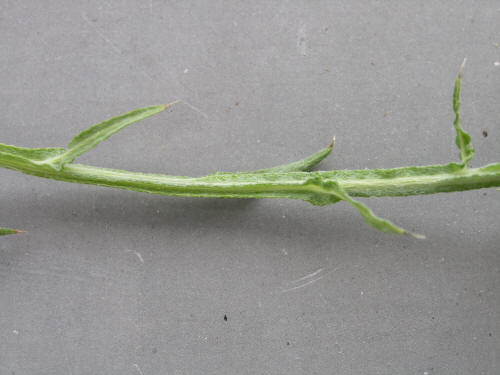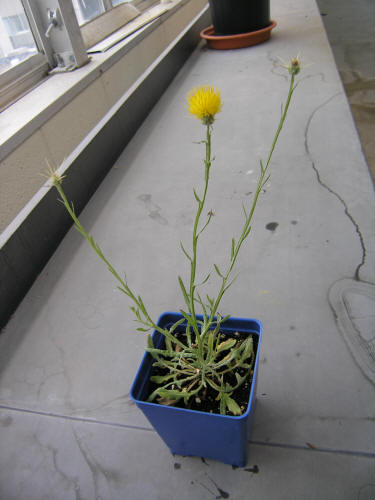Go to Midwest Weeds and Wildflowers Home Page
Yellow Starthistle
Centaurea solstitialis L.
Asteraceae (Sunflower Family)
▲▼young plant rosette
▲young plant rosette
▲▼ young mature plant, with flower buds; basal leaves shown below
▲ young mature plants, with immature rosettes around it

▲ winged stems covered in fine hairs
▲▼mature, flowering plants

▲▼mass of flowers in large plant cluster
▲▼ large plant showing the woolly, winged stems below the flowers
▲▼ inflorescences/flowers
▲▼flower details
▲▼flower details
▲▼flower details
▲▼flower details
▲▼flower details

▲ large population near rodeo grounds in New Mexico
Centaurea solstitialis L., Yellow Starthistle: (Bayer Code: CENSO; US Code CESO3)
· In same genus as spotted knapweed, but has bright yellow flowers with long, sharp spines attached to involucre bracts
· Native to Mediterranean region, it is mainly found in western states, but occasional appearances in Midwest has it on many states’ noxious weeds lists
· Has hairy, blue-green, lobed leaves in basal rosette, then thin, lanceolate, hairy leaves on hairy stems below inflorescences
· Flowering stems have leafy (non-spiny) “wings” along their length)
· Can form dense, impenetrable populations where uncontrolled, and can spread readily by seed
· Similar species:
o Malta Starthistle (Centaurea melitensis) has similar basal rosettes, but more robust flowering stems and more branching than spotted knapweed; stems and leaves are hairy; stems also winged ; however, Malta Starthistle flower heads are slightly smaller, with shorter disk flowers and much shorter spines arising from bracts below the inflorescence, and usually more bracts below the inflorescence than yellow starthistle
Go to Midwest Weeds and Wildflowers Home Page
Updated 23 January 2019